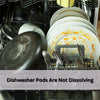How to Clean Rangehood Filters Without Harsh Chemicals
- by Brodie Cook

Have you ever looked up while cooking and noticed a sticky patch or a drip forming under your rangehood? Or worse, had something fall into your food mid-stir? It’s the kind of thing you pretend didn’t happen. You knew straight away it wasn’t good. If you’ve been cooking most nights, there’s a good chance the filter above your stove has built up a layer of grease that’s long overdue for a clean.
A dirty filter doesn’t just look bad. It holds onto cooking smells and stops the fan from working like it should. You might hear it running, but it stops pulling air and just makes noise for no reason. The good news is you don’t need harsh sprays or a big scrub to sort it out.
There’s an easier way to lift the grease and keep things clean.
What You’ll Need to clean rangehood filters
You don’t need much to clean a greasy rangehood filter. Most of this will already be in your kitchen.
-
A sink or tub big enough to soak the filter
-
Boiling water (from the kettle works best)
-
A non-scratch scrubbing brush
-
Tongs or a wooden spoon (for stirring, not your hands)
-
A towel or dish rack for drying
Step-by-Step: Clean Your Rangehood Filter Naturally

Remove the filter from the hood
Most filters slide or pop out from underneath. Some have a small tab to pull. If there’s a screw, use a screwdriver to loosen it before sliding the filter out. Keep a towel nearby in case it drips.
Fill your sink or basin with boiling water
Boil the kettle and fill the sink until the filter will be fully covered. Hot water helps loosen the grease faster. Tap water usually isn’t hot enough on its own.
Drop in one Lucent Globe Dishwashing Sheet
Tear the sheet in half if your filter is small. Stir the water with a wooden spoon or tongs until the sheet dissolves. For an extra boost, add half a cup of white vinegar. It helps break down thick grease and smells.
Submerge the filter and let it soak
Place the filter flat in the water. If it floats up, use a mug to make sure it stays submerged. Let it soak for 30 to 60 minutes, or until the water cools down.
Scrub gently with a toothbrush or soft brush
Once the filter has soaked, give it a gentle scrub with an old toothbrush or soft cleaning brush. Focus on the corners and mesh where grease tends to stick. You shouldn’t need much pressure.
Rinse with hot water and check for grease
Run hot water over the filter to rinse off any leftover soap or grime. If parts still feel sticky, you can repeat the process. It must have been super dirty.
Let it dry upright before putting it back
Stand the filter up on a towel to let the water drain. You can also place it outside in the sun to dry faster. Make sure it’s fully dry before reinstalling.
Repeat if needed
If the filter hasn’t been cleaned in a long time, it might need another soak. Just refill the sink with fresh hot water and repeat the process.
Why Avoid Harsh Degreasers
Most supermarket degreasers are strong enough to clean, but they come with downsides. The smell can hang in the air long after you’re done. Some even leave behind a sticky film that needs rinsing twice.
These often contain chemicals that aren’t great to breathe in, especially in a small kitchen. You may also need gloves to use them safely.
Using hot water and a dishwashing sheet means you’re not spraying anything around your stove. There’s no strong scent and no bleach. Just a clean filter and a kitchen that smells like food, not chemicals.
Common questions when it comes to cleaning the rangehood & filter
How do I know when my rangehood filter needs cleaning?
If the fan sounds louder than usual but doesn’t seem to pull air, the filter might be clogged. You might also notice steam lingering longer after cooking, or a sticky feeling when you touch the underside of the hood. In some cases, the filter may start to look yellow or feel greasy to the touch, even when dry.
Can I clean aluminium filters the same way?
Yes, aluminium filters can be cleaned using the same soak method. Just skip any scrubbers with metal bristles, as they can scratch the surface. A soft brush or toothbrush is enough to lift grease once the sheet and vinegar have had time to work.
What happens if I never clean my rangehood filter?
Grease will build up over time, blocking airflow and leaving your kitchen stuffy. A clogged filter also puts more strain on the fan motor and may cause it to wear out faster. In some cases, drips can fall back onto your cooktop, especially when the hood heats up.
How often should I clean my rangehood filter?
Once a month is a good routine for most home kitchens. If you cook often or use a lot of oil, every two to three weeks is better. Filters in rental homes or shared kitchens may need more frequent cleaning. A quick visual check each week helps you stay on top of it.
See? That Was Easy
No need to mess around with strong chemicals or spend half the day scrubbing. Just soak your filter in hot water with our dishwashing sheet and let it do the hard work. Clean filter, no fuss, and no harsh smells left behind.
Give it a try next time your rangehood looks a bit greasy. You’ll be surprised how simple it is.

 Dishwashing
Dishwashing Laundry
Laundry Bundles
Bundles Surfaces
Surfaces Toilet
Toilet Handsoap
Handsoap Multi-Purpose
Multi-Purpose Floor
Floor



